 Buy Now
Buy Now
Max: 1

Practice Manual used at Vajra Vidya Retreat Center (VVRC) in Crestone, Colorado. List of practices Dorje Chang Tungma Kagyu Lineage Prayer Kangloma Praise of Manjushri Eight Noble Auspicious Ones ( Tashi Prayer ) Mandala Offering Long Life Prayers Dedication of Merit Lord...
 ... more info
... more info
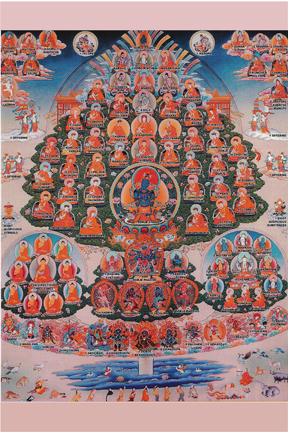
The Kagyu lineage tree not only has the lineage masters down to the 16th Karmapa, but it also contains the important sacred sangha and yidams and protectors of the lineage and other important realized individuals such as Niguma, Khentse Wangpo, Machtig Ladron, Pagmo Drukpa and Dolpopa. This lineage...
$2.00 Buy Now

The Kagyu lineage tree not only has the lineage masters down to the 16th Karmapa, but it also contains the important sacred sangha and yidams and protectors of the lineage and other important realized individuals such as Niguma, Khentse Wangpo, Machtig Ladron, Pagmo Drukpa and Dolpopa. This lineage...
 Buy Now
Buy Now

Khenpo Karthar was actually Thrangu Rinpoche's teacher when he was young and these two Rinpoches have been communicating and helping each other ever since until the death of Khenpo Karthar. In this 47 booklet Khenpo Karthar goes into detail about what it means to take refuge
 Buy Now
Buy Now

The refuge ceremony is a formal way of saying that you would like to follow the Buddhist teachings. You take it only once and it does not require you to follow any particular lineage or set of teachings.
 Buy Now
Buy Now

Before one begins to do practice or receive certain teachings, one must take the Refuge Vow. In this four page text David Karma Choephel who has been Thrangu Rinpoche's translator for the last decade, gives a description of what the Refuge Vow means and explains the brief ceremony involved. ...
 Buy Now
Buy Now

The Bodhisattva Vow is taken some time after one has taken the Refuge Vow. When one understand what a bodhisattva is and what it entail, one can take this vow. It should be done from a qualified teacher and does not have to be from one's root guru. A bodhisattva is described in great detail in...
 Buy Now
Buy Now

Khenpo Karthar was asked many times about how one could set up a shrine in one's house or appartment. This small booklet is some answers to this question.
 Buy Now
Buy Now
Max: 1

This book is a very good one to begin with because Bokar Rinpoche has done something I have rarely seen in any other book. It begins when we wake up each day and what our first thought is, then how we expel the residual breath of the night. Then he gives instructions of setting up a simple...
 ... more info
... more info
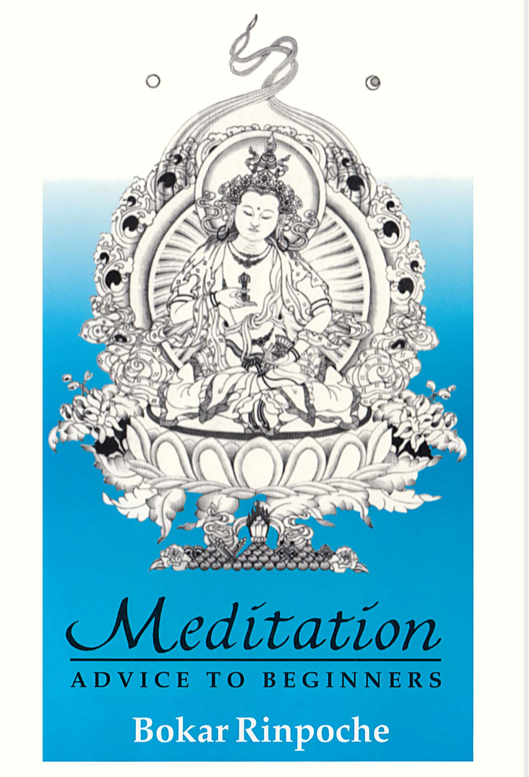
Bokar Rinpoche has written this very good book of 140 pages directed towards students beginning the practice of meditation. In this book he begins with why do we meditate and what are the results of meditation. He then goes in a very direct way explaining problems which may come up in meditation...
 Buy Now
Buy Now

Mingjur Rinpoche when he was just 17 years old when he composed this Amitabha Sadhana or Practice. It is the one most often used in the Kagyu Lineage. Amitabha is one of the five main Wisdom Buddhas and his pure realm is Sukhavati. Chenrezig belongs to the Amitabha family and therefore has Amitabha...
 Buy Now
Buy Now

The brief prayer to be reborn in Amitabha's pure land of Sukhavati (Tibetan Dewachen) is mentioned in the Chenrezig prayer. The reason Sukhavati is important is that most of the pure lands that exist do not allow individuals who have not attained the higher bodhisattva's...
 Buy Now
Buy Now

If you are doing this practice it is always good to know the melody of the practice. This MP3 can be copied onto you computer, tablet, or phone and has particularly clear pronunciation and excellent singing voices. This is a FREE download. You can download it when you check out.
 Buy Now
Buy Now

This 18 page commentary by Tenga Rinpoche on how to do the Amitabha practice which actually comes from the internet. This is a very thorough commentary on the practice and Tenga Rinpoche also has a detailed description of Sukhavati, the pure land of Amitabha. This is a free download. You can...
 Buy Now
Buy Now

We are forunate to have a translation of the Amitabha Sutra. This sutra is extremely well known in China. The Chinese brought this sutra back from India over 1,000 years ago and translated it into Chinese. Since then this sutra is the background to all Amitabha practices. Amitabha is also one of...
 Buy Now
Buy Now

This is a wonderful short video of the Amitabha practice which has the chanting and below are the transliterated Tibetan words. We got this from the internet so we made it free. It is quite good and we think it could be beneficial in doing the practice. This is a FREE download. You can...
$7.00 Buy Now

Before one begins any practice, one should contemplate the four the four ordinary foundations often called the four thoughts that turn the mind (towards the Dharma). The first foundation, precious human birth, explains in detail why practice is important. The second foundation, impermanence,...
 ... more info
... more info

Chenrezig also known Avalokiteshvara is the most popular deity in Tibet. Chenrezig is the deity representing complete, universal compassion and his mantra is the famous: OM MANI PEDME HUNG (Tibetan pronunciation). Chenrezig is the patron saint of Tibet. The Chenrezig practice, for example, is done...
 Buy Now
Buy Now

It is often hard to do Chenrezig Practice with the proper tune. Here we have Lama Kathy who has a beautiful voice doing the practice. When you download this free MP3, you can copy it to your phone or tablet and play it any time that you practice.
 Buy Now
Buy Now

The Chenrezig practice is a very powerful way to develop one's compassion and it has a wonderful tune making it a beautiful and joyful practice. This is a practice booklet of the Chenrezig practice. It contains the orginal Tibetan script, the transliteration, and the English translation...
$2.00 Buy Now

Chenrezig also known by his Sanskrit name Avalokiteshvara is the most popular deity in Tibet. He is the deity of representing compassion and his mantra is the famous: OM MANI PEDME HUNG. The Chenrezig practice is done every night by the children attending Thrangu Rinpoche's grade school in...
 Buy Now
Buy Now
Max: 1

The Chenrezig Practice has a beautiful tune and I had the wonderful experience of hearing the children of Thrangu Ripoche's school in Nepal singing this practice each evenening before leaving school. Here we have Lama Kathy who well known as a teacher in the US singing the Chenrezig practice....
 Buy Now
Buy Now

Khenpo Karthar Rinpoche gives a very detailed explanation of the Chrenrezig practice in 45 pages. If you want to thoroughly understand this practice, this would be an excellent resource.
$0.50... more info
Max: 1

Chenrezig also known by his Sanskrit name Avalokiteshvara is the most popular deity in Tibet. He is the deity of representing compassion and his mantra is the famous: OM MANI PEDME HUNG. The Chenrezig practice is done every night by the children attending Thrangu Rinpoche's grade school in...
$2.00 Buy Now

Chenrezig also known by his Sanskrit name Avalokiteshvara is the most popular deity in Tibet. He is the deity of representing compassion and his mantra is the famous: OM MANI PEDME HUNG. The Chenrezig practice is done every night by the children attending his school in Nepal. The practice has...
$1.25 Buy Now
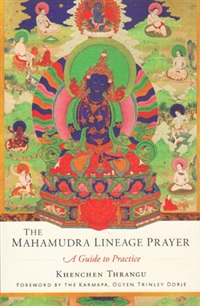
One of the most beloved and often recited prayers in the Kagyu tradition of Tibetan Buddhism. The Mahamudra Lineage Prayer , also called the Dorje Chang Prayer combines a supplication to the Mahamudra lineage with a concise guide to Mahamudra practice and the stages of the path to enlightenment. ...
$1.25 Buy Now

Karma Chagme who holds the Kagyu Lineage and also the Nyingma lineage wrote this Aspiration of Sukhavati. Sukhavati (Tib. Dewachen) is the pure land that very devoted practiioners may enter and continue their practice uninmepded by samsara. This 41 page booklet is an English translation of this...
 Buy Now
Buy Now

This is an MP3 Download of Thrangu Rinpoche teaching the Chod practice. Chod which litterally means to "cut off" is a practice developed by the great woman practitioners Machig Labrang that has the aim of giving up one's self-cherishing. As long as we have a strong sense of self and...
 Buy Now
Buy Now

The main chöd practice, pronounced Chö, originated by a Tibetan, Machig Lhabron, and is known because it is the only proctice which become so famous that it was actually brought to India from Tibet. Chö meaning "cut" is a Vajrayana practice to cut one's ego. We as...
$1.25 Buy Now

Cutting Off or Chod (pronounced Cho) Practice was developed by Machig Labrag is one of the only Buddhist practices to be developed in Tibet and was then taken back to India. Chod literally means "cutting off" and refers to cutting off one's ego. This book gives the practice as...
$1.25 Buy Now

This is an amazing manual on doing the Chod practice. The manual has 115 pages of explanation and then the whole Chod practice is given in Tibetan script and also in Tibetan pechas. In addition to this there are 28 diagrams of what one should visualize. This manual is a translation of 14th...
$9.95 Buy Now

Thrangu Rinpoche recites The Kagyu Lineage Prayer (Tib. Dorje Chang Tungma ) every single time that he gives a Buddhist teaching. He does because this prayer has immense blessings and it settles the mind into relating to the Dharma because it outlines the whole Mahamudra path in less than a dozen...
 Buy Now
Buy Now

Thrangu Rinpoche says The Kagyu Lineage Prayer (Tib. Dorje Chang Tungma ) every single time that he gives a teaching. He does this because this prayer has immense blessings and that it outlines the whole Mahamudra path in less than a dozen verses. This Kagyu Lineage Prayer with guidance gives...
 Buy Now
Buy Now

This is David Karma Choephel chanting the Kagyu lineage prayer with Thrangu Rinpoche.
$15.00 Buy Now

One of Thrangu Rinpoche's most popular publications . The Medicine Buddha which consists of over 200 pages translated by Lama Yeshe Gyamptso and has basically four different parts. First there is an 87 page verse-by-verse explanation of how to do eveery single part of the actual...
$7.00 Buy Now

Mipham Rinpoche, a 19th century Tibetan scholar and practitioner, gives a definitive explanation of the Middle-way Instructions. For a few years he stayed at the Tenth Thrangu Rinpoche's monastery, where he was supplied with the materials for his prolific writing. One of Mipham Rinpoche's...
$16.00 Buy Now

The foundation of all meditation practice are the two types of meditation that form the core of Buddhist spiritual practice: Tranquillity (Shamatha) meditation which aims at stilling the mind and Insight meditation (Vipasyana) meditation produces insight into the nature of all phenomena. Shamatha...
$1.25 Buy Now

The foundation of all meditation practice are the two types of meditation that form the core of Buddhist spiritual practice: Tranquillity (Shamatha) meditation which aims at stilling the mind and Insight meditation (Vipasyana) meditation produces insight into the nature of all phenomena. Shamatha...
 Buy Now
Buy Now

Padmasambhava or Guru Rinpoche was one of the major founders of Buddhism in Tibet. He introduced the Vajrayana to Tibet and is known by the Tibetans as being the “second Buddha.” There are many practices of Guru Rinpoche and he is often depicted as dispelling negative forces with his...
 Buy Now
Buy Now

This is the Kongchog Chidu (Guru Rinpoche) practice with Lama Tashi leading. This is a FREE download.
$1.25... more info
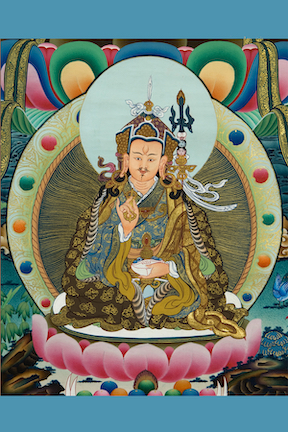
Guru Rinpoche (Padmasambhava) was considered a second Buddha in Tibet because he brought Buddhism from India to Tibet and established its first lineage--the Nyingma lineage. In this depiction Guru Rinpoche is in the mudra of the Konchog Chidu Practice on a lotus throne with his staff which...
 Buy Now
Buy Now

Mahakala is a practice done every evening in almost all Kagyu monasteries. NO matter where Thrangu Rinpoche is --in a hotel or visiting someone in thier house, he does Mahakala practice. Mahakala is a wrathful protector who protects the Karmapa and his teachings. To do the full hour long Mahakala...
 Buy Now
Buy Now

The Mahakala practice is usually done with a drum in the monastery, however, it is fine to do it with just tapping to imitate the drum beat. Here Khenpo Jigme is doing it with the full set of instruments at the Vajra Vidya Retreat Center.
 Buy Now
Buy Now

The Manjushri Prayer is every day by the participants in the shedra when they begin studying the Sutras and other texts. Manjushri is the deity most closely associated with wisdom. He hold a sword in his right hand to cut the confusion of thought and the Prajnaparamita, the famous sutra explaining...
$0.50... more info
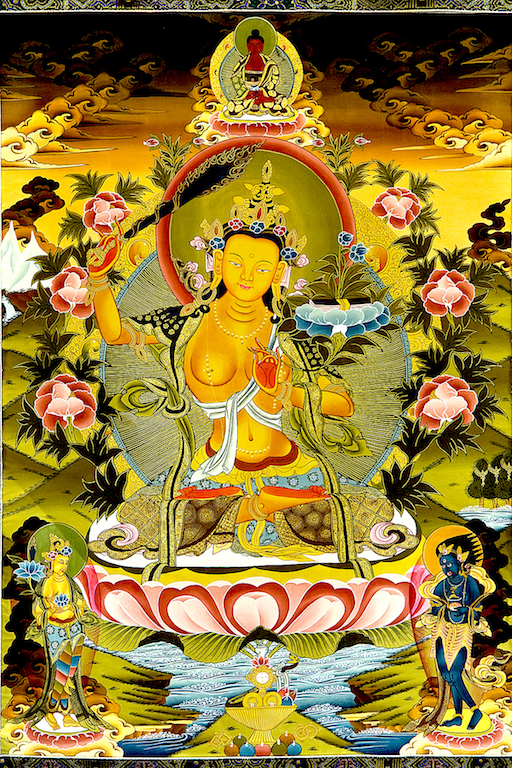
This is a photo of Manjushri to go with the Manjushri practice.
 Buy Now
Buy Now

Here is Khenpo Jigme chanting the Manjushri Prayer.
 Buy Now
Buy Now
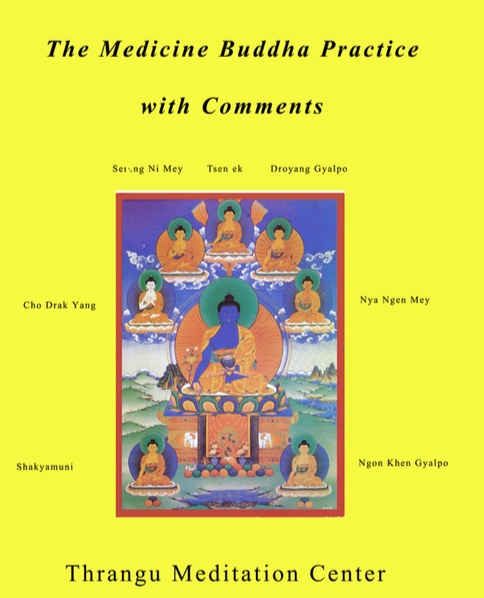
The Medicine Buddha is a favorite practice of many which is a practice to help all those with mental and medical problems. It is practiced by all sects of Tibetan Buddhism. The Medicine Buddha with Guidance is a 36 page PDF of the Medicine Buddha Practice in Tibetan script, transliteration,...
 Buy Now
Buy Now

This is the Medicine Buddha Practice chanted by Lama Tashi. Lama Tashi has a very clear voice and led the practices on an number of Thrangu Rinpoche's teachings.
 Buy Now
Buy Now

Al the various Medicine Buddha Practices are based on this Sutra which has been translated into English by Mimh Thanh. Since he offered this translation for free, we also are honored to offer it for no cost.
$0.50 Buy Now

This photo shows the Medicine Buddha surrounded by the seven other "brother" Medicine Buddhas. Please go to the Photo section and select the size of the photo (4x6) or (8x10) and if you want the high quality photo sent to you with free postage. If you want to download a photo of of...
$1.25 Buy Now

An important part of the path of meditation in the Kagyu Lineage is to do the Common Preliminaries and then to do the Special Preliminaries called ngondro in Tibetan. The consists of doing 100,000 prostations and recitation of refuge to develop basic faith in Buddhism, Purication practice...
Buy Now

Anyone one who want to throughly understand the Nyungne Practice and know how to do it should get this 270 page book devoted completely to this one practice. It also contains several color illustrations.
 Buy Now
Buy Now

The foundation of ALL meditation practice are the two types of meditation that form the core of Buddhist spiritual practice: Tranquillity (Shamatha) meditation which aims at stilling the mind and Insight meditation (Vipasyana) meditation produces insight into the nature of all phenomena. Shamatha...
$1.25 Buy Now

Thrangu Rinpoche discusses the four common foundations, which are the four thoughts to contemplate before beginning any spiritual practice. The first foundation, precious human birth, explains in detail why practice is important. The second foundation, impermanence, teaches us to find something...
 Buy Now
Buy Now

There are several ways to reduce our concern, even our obsession, with our self. We cannot truely develop good Buddhist practice without also working on selflessness in which we treat others as important or even more important than ourself. One way to develop selflessness is to do intensive study...
 Buy Now
Buy Now

The Prayer to be reborn in Sukhavati (Tib. Dewachen) is a short prayer that is often chanted at the end of session, particularly with the Chenrezig practice. One of the ways to have a very favorable birth is to develop the strong intention that when you die you will go to the pure land of...
 Buy Now
Buy Now

The whole Sukhavati practice of aspiring to go to the pure land of the Amitabha Buddha after one dies is based on an actual sutra of The Buddha. In this sutra a desciption of Sukhavati iand an outline of what has to be done to go there is given. All the practices of Sukhavati are based on this...
 Buy Now
Buy Now

This is an MP3 file of Thrangu Rinpoche and his monks chanting the Sukhavati prayer which has a beautiful tune. You can download this and put it on your computer, tablet, or phone.
 Buy Now
Buy Now

The Tashi Prayer or The Verses of the Eight Auspicious Noble Ones is a prayer composed by Jamgon Kongtrul to build up auspicious or good fortune. Khenpo Karthar used to recite this prayer when students came to him with problems that he could not solve right there to help them. the prayer is based...
 Buy Now
Buy Now

White Tara is practiced by all four major schools in Tibet. There are actually several Tara practices with the best know being White Tara and Green Tara. The Practice of White Tara is a practice to protect all sentient beings from harm of all kinds and has a special function is to promote long...
 Buy Now
Buy Now

Here is Khenpo Jigme chanting the White Tara Practice so that one can get the tune correct.
$1.25 Buy Now

White Tara is practiced by all four major schools in Tibet. There are actually several Tara practices, but White Tara's special function is to promote long life both for the practitioner and for all others. Ultimately, White Tara is the nature of Dharmakaya and accomplishing her practice leads...
 Buy Now
Buy Now

This is a book byTaranatha who collected a lot of stories about Tara and these were translated by Templeman. Taranatha apparently through together 89 references to Tara of mostly non-scholars had never heard of. It is a testament to Taranatha's apparent photographic memory, but it is a...









































